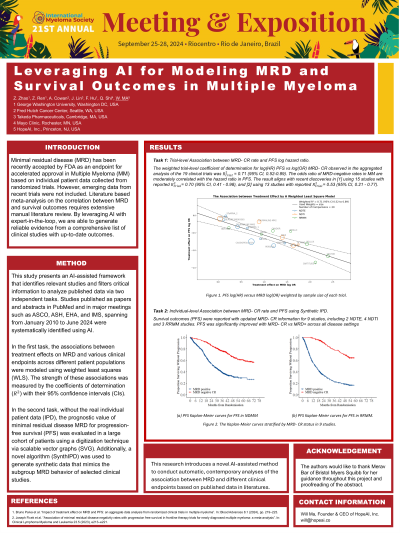MRD and Biomarkers
Leveraging AI for Modeling MRD and Survival Outcomes in Multiple Myeloma Based on Comprehensive and Up-to-Date Clinical Evidence
P-178: Leveraging AI for Modeling MRD and Survival Outcomes in Multiple Myeloma Based on Comprehensive and Up-to-Date Clinical Evidence
Friday, September 27, 2024


Will Ma
Founder & CEO
HopeAI, Inc., New Jersey, United States
Introduction: Minimal residual disease (MRD) has been recently accepted by FDA as an endpoint for accelerated approval in multiple myeloma. Aggregate analysis on the correlation between MRD and survival outcomes requires extensive manual literature review. By leveraging AI with expert-in-the-loop, we are able to generate reliable evidence from a comprehensive list of clinical studies with up-to-date outcomes.
Methods: This study presents an AI-assisted framework that identifies relevant studies and filters critical information to analyze clinical data. The associations between MRD and various survival endpoints across different patient populations were modeled using weighted least squares. The strength of these associations was measured by the coefficients of determination (R²) with their 95% confidence intervals.
Results: The AI searched for eligible studies reporting progression-free survival (PFS), overall survival (OS), overall response rates (ORR), and MRD data with more than 50 patients per treatment arm, using next-generation flow cytometry or sequencing methods with a minimum sensitivity of 10^-5 from January 1, 2010, to May 29, 2024. This enabled us to extend the list of studies from 15 to 26 trials. The analysis results reported R² of 0.75 (0.58 - 0.92) for PFS hazard ratio (HR) versus MRD negativity odds ratio (MRD- OR); 0.44 (0.14 - 0.75) for OS HR versus MRD- OR; and 0.54 (0.27 - 0.80) for ORR OR versus MRD- OR. Subpopulation analysis yielded R² of 0.64 (0.38 - 0.90), 0.85 (0.73 - 0.97), and 0.75 (0.56 - 0.94) for PFS HR versus MRD OR in newly diagnosed transplant-eligible, newly diagnosed transplant-ineligible, and relapsed or refractory MM patients, respectively.
Conclusions: This research introduces a novel way to conduct automatic, contemporary analyses of the association between MRD and different survival endpoints. Furthermore, the analysis results corroborate the validity of using MRD as an endpoint for accelerated approval.
Methods: This study presents an AI-assisted framework that identifies relevant studies and filters critical information to analyze clinical data. The associations between MRD and various survival endpoints across different patient populations were modeled using weighted least squares. The strength of these associations was measured by the coefficients of determination (R²) with their 95% confidence intervals.
Results: The AI searched for eligible studies reporting progression-free survival (PFS), overall survival (OS), overall response rates (ORR), and MRD data with more than 50 patients per treatment arm, using next-generation flow cytometry or sequencing methods with a minimum sensitivity of 10^-5 from January 1, 2010, to May 29, 2024. This enabled us to extend the list of studies from 15 to 26 trials. The analysis results reported R² of 0.75 (0.58 - 0.92) for PFS hazard ratio (HR) versus MRD negativity odds ratio (MRD- OR); 0.44 (0.14 - 0.75) for OS HR versus MRD- OR; and 0.54 (0.27 - 0.80) for ORR OR versus MRD- OR. Subpopulation analysis yielded R² of 0.64 (0.38 - 0.90), 0.85 (0.73 - 0.97), and 0.75 (0.56 - 0.94) for PFS HR versus MRD OR in newly diagnosed transplant-eligible, newly diagnosed transplant-ineligible, and relapsed or refractory MM patients, respectively.
Conclusions: This research introduces a novel way to conduct automatic, contemporary analyses of the association between MRD and different survival endpoints. Furthermore, the analysis results corroborate the validity of using MRD as an endpoint for accelerated approval.